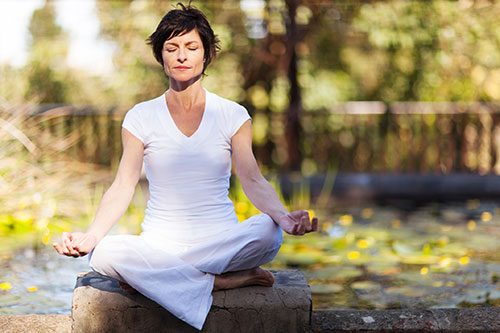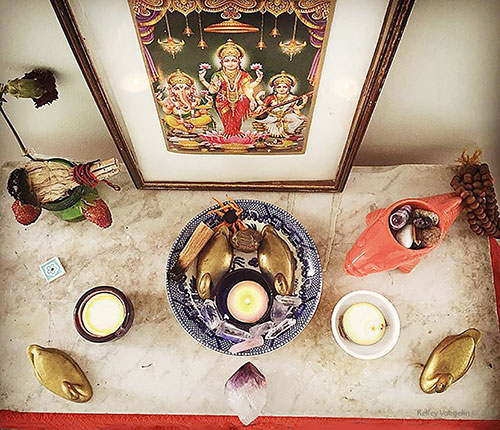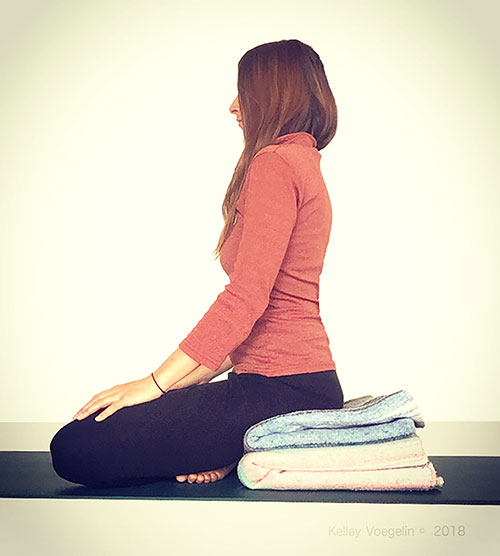Let’s be honest — it’s hard to keep up a meditation practice. We try to meditate for a stretch, feeling good and motivated about it until life tugs us in one direction or another, and then weeks go by and we realize we’ve forgotten about meditating.

If you’ve been trying to add regular meditation to your life, you may have found yourself saying:
- I can’t focus.
- I don’t feel quiet.
- I can’t get comfortable.
- I don’t have time.
- I have too many other things to do.
- I’m not sure if I’m doing it right.
If any of these excuses sound familiar, take heart. Most of us share these challenges.
So, how do you stay motivated and on track with your meditation practice?
Realistic expectations set you up for success with meditation
First of all, it’s important to be truthful with yourself about how to make your meditation practice sustainable. You’ll have to experiment with what works for you. Increase the chances for success by looking into the different styles of meditation.Explore different seated positions, as well as a variety of times in the day that might resonate with you.
If you haven’t meditated a lot, or you’ve gotten rusty, you might also need a refresher meditation class. Having someone else guide you is an effective way to become interested in meditating again.
What will you focus on when you meditate?
If breath-centered meditation doesn’t hold your attention, try focusing on an object,a specific chakra, a mudra, a mantra — or even a sentiment that means something to you. Forcing yourself to pick one specific meditation tradition might fuel resistance,frustration and lack of motivation. Try to give yourself the space and time to try several styles.
You may relish the opportunity to sit down and just simply let your mind sift and settle without focusing on something specific. Or, perhaps your consciousness needs to work through an issue. The time you set aside to sit quietly and let your mind roam could be what you need to let go of a problem or distraction so you feel settled and, eventually, clearer.
Be bold and consider that following your mind’s train of thought to find where it leads is not necessarily a bad thing.
Keep meditation simple
Keep the practice simple and take small steady steps — that will keep you inspired and on track. It’s a big help to set realistic intentions and let them be what they are:
- today, I meditate for spaciousness.
- today, I meditate for mental calm.
- today, I meditate to feel grounded.
Please don’t feel disappointed or inadequate if, at the end of your meditation time,you didn’t experience a major and magical shift. Some days you might feel like not much happened but on other days, you might experience an “aha” moment or end up feeling really at peace.
Remove distractions to help with focus
The space you choose for meditation matters. It should be, and stay, clear of distractions.Let yourself be alone, shut the door, turn off your phone unless you are using it as a timer, and if so, silence it. Close your eyes or gaze downward at one spot,and let yourself feel soft and empty of thought.
If the “dust bunnies” in the corner are truly distracting you, go on and sweep them up — then go meditate. Got a list of things to do? Let yourself take the time to write it down, and get it off your mind— then go meditate. Can’t really start your day until the bed is made? Okay, tidy up as needed — then go meditate.
I’m not saying that getting everything done is a prerequisite to meditation or you might never get to the cushion. But if something is going to gnaw at you the entire time you’re sitting there — and it’s simple and easy enough to take care of — just do it in order to have a more peaceful session.
When you clear your space, you clear your mind. Remove external distractions so you can focus on the internal work.
Meditate in the same place if you can
You can meditate anywhere— at home, at your desk, during yoga. However, setting aside a sacred place that is all your own will encourage your meditation commitment.
As you show up over and over to this dedicated spot, you cultivate positive energy in your meditation space, which draws you in and makes you want to be there more and more often.

While it’s not a requirement, a special space that you create for meditation, like an altar, will call you toward it because it has meaning to you. Your altar could be a small table or shelf with candles, with a picture of a sacred design, place or deity. You may want to have incense and plants or anything else that’s special to you and supports your effort to sit quietly. If you don’t have space for an altar,you can keep one meaningful object nearby that inspires you.
What’s the right time to meditate?
Pick a time of day to meditate that you know works for you. If you are not an early riser, don’t expect to get up at sunrise each day and pop a squat on your cushion.That expectation will cause guilt about hitting the snooze button and skipping your practice.
Choose a time that makes sense in your schedule. Maybe it’s before you make your morning coffee or in the wind-down time at night? As best you can, try to stick to that time each day. Eventually your internal meditation clock will start to chime then and you’ll naturally and willingly step toward your practice.
Set a meditation session timer
Setting a timer helps manage your expectations about the meditation experience —you won’t be distracted by worrying you will go over and be late for something.It also saves you from having to glance at the clock or phone. It’ll be understood that you have dedicated “x” amount of time today. Then set the timer and do your best to be fully with your practice until the alarm goes off.
But again, it’s so important to be honest with yourself. If you truly don’t have 20 minutes to commit today, then try for 10 instead. If that inner voice starts whispering that you just don’t have the time for this today, could you make room for possibility that yes, you probably do have the time?
Listen to your voice but don’t shy away from the steps it takes to make meditation become a pattern in your regular life.
Try a meditation app
Many meditation apps are available to be downloaded onto your phone — some are free while others charge a small fee. These offer different features like guided imagery,breath-centered meditations, calming sounds, timers, reminders, etc.
Meditation apps keep track of your progress and can help you to build your meditation muscles. Simply type “meditation app” into your app store or online search engine and check some out.

Build up your practice bit by bit
Start with small doses of meditation and work your way up to longer sessions. It’s better to do more short sessions each day with consistency than it is to have long sessions that are few and far in between. I’m not the first person to recommend this strategy. If you can only allot 5 minutes each day to sit and breathe,that’s better than 20 minutes on one day and then nothing for a week. Over time,your 5 minute sessions will grow into longer ones.
I find that when I sit for longer stretches, those first few minutes are often filled with thoughts. As more time passes, my mind gets quieter, clearer and calmer. I work toward that with patience and practice. You can too.
Good posture helps
Sit any way that your back and hips feel supported and comfortable — cross-legged,on your shins, perched on a cushion, blankets, in a chair, or lying down. When we have right posture, our energies will also be aligned and free flowing. This helps the body and mind feel at ease during meditation.

The right attitude makes meditating easier
Make sure to take a moment to ponder how fortunate you are that you found meditation in the first place. Imagine if you never knew about it or had the inspiration to try it. What if you didn’t care about nurturing your mind or creating a mindfulness practice? This helps you sit down with gratitude and acknowledge that you put effort toward something that is extremely beneficial, even if it’s sometimes hard to commit to.
Please have compassion for yourself. You are human and life does happen — work gets busy, vacations are scheduled, family members need your support. It’s not the end of the world if you miss a day. Just don’t let missing your practice become the new routine.
Meditation helps you find the balance in life to make space for all the people and things that matter.
The takeaway: let your meditation practice unfold
Consistency is your ally when it comes to meditating — same time, same place, special space, supported posture, small steps and steady practice. Simply setting as idea bit of time each day to sit, slow down and center is enough in and of itself,no matter how you think it goes. That’s meditation, too.
All of the external distractions and inner chatter will come and go, ebb and flow,and dance around you daily. However, your meditation practice, and the pure, clear you that it roots for and strengthens, will eternally be there.
You always have the opportunity to start again, to tap in to your inner self. Try it today. Try it again tomorrow. It’s always here for you.
 |
How can you turn off your racing thoughts? Here are ideas and techniques to calm your mind. |










